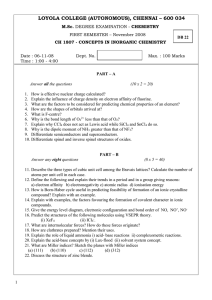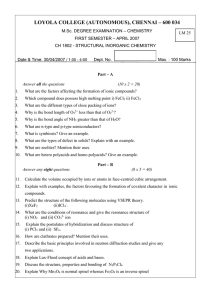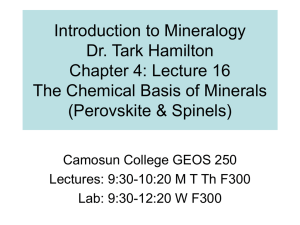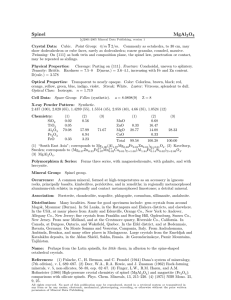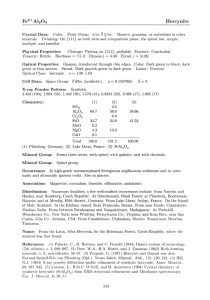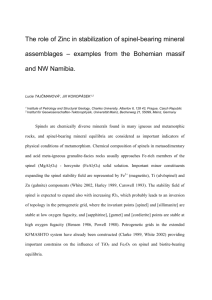Magnesium Aluminate Spinel Raw Materials for High
advertisement
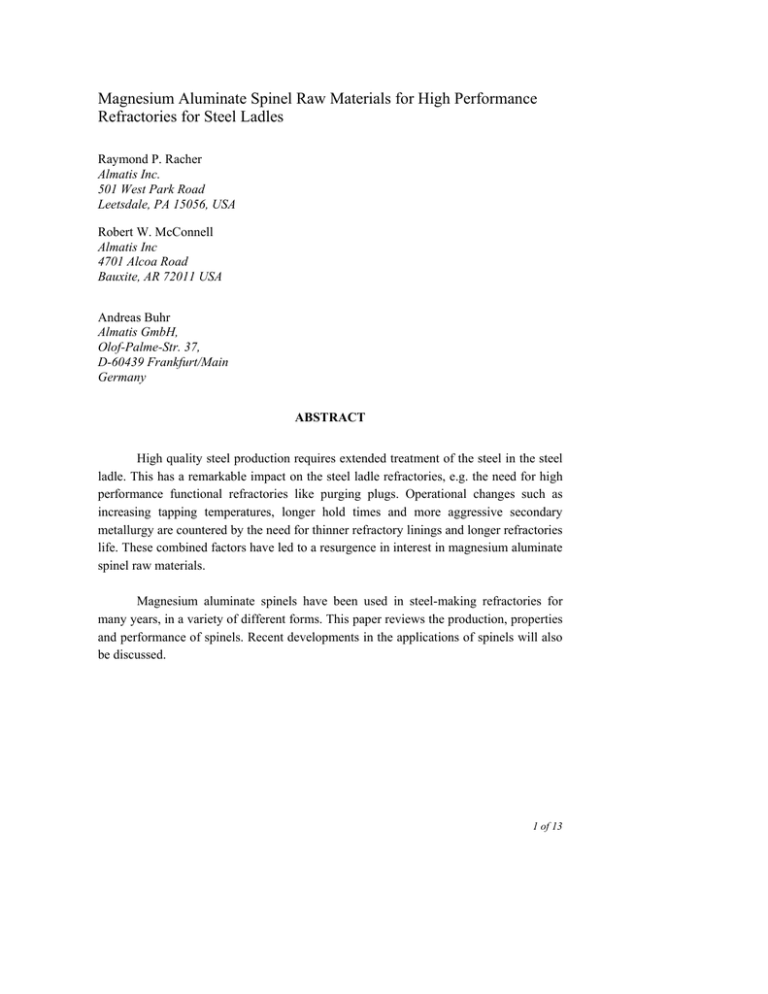
Magnesium Aluminate Spinel Raw Materials for High Performance Refractories for Steel Ladles Raymond P. Racher Almatis Inc. 501 West Park Road Leetsdale, PA 15056, USA Robert W. McConnell Almatis Inc 4701 Alcoa Road Bauxite, AR 72011 USA Andreas Buhr Almatis GmbH, Olof-Palme-Str. 37, D-60439 Frankfurt/Main Germany ABSTRACT High quality steel production requires extended treatment of the steel in the steel ladle. This has a remarkable impact on the steel ladle refractories, e.g. the need for high performance functional refractories like purging plugs. Operational changes such as increasing tapping temperatures, longer hold times and more aggressive secondary metallurgy are countered by the need for thinner refractory linings and longer refractories life. These combined factors have led to a resurgence in interest in magnesium aluminate spinel raw materials. Magnesium aluminate spinels have been used in steel-making refractories for many years, in a variety of different forms. This paper reviews the production, properties and performance of spinels. Recent developments in the applications of spinels will also be discussed. 1 of 13 INTRODUCTION This paper discusses the structure, properties and applications of magnesium aluminate spinels, with particular reference to their advantages in formulating refractories for clean-steel production. Magnesium aluminate spinels are increasingly being used in refractories for steelmaking due to their particular combination of resistance to steel-making slag corrosion, thermal shock resistance and excellent hot strength. Spinel refractories were initially (mid-1960’s) produced by the in-situ reaction of alumina with periclase in magnesia bricks for linings of cement kilns. The availability of high-quality pre-reacted spinels has opened the possibilities of developing high purity refractories in both monolith and brick form. PROPERTIES Structure Magnesium aluminate spinel is a member of a group of oxides that have the same crystal structure, which is named the spinel structure. The spinel group contains over twenty members, but only a few are considered common. The general formula of the spinel group is AB2O4, where A represents a divalent metal ion such as magnesium, iron, nickel, manganese and/or zinc, and B represents trivalent metal ions such as aluminum, iron, chromium or manganese. Unless otherwise described, the term “spinel” in this paper will refer to MgAl2O4, the mineral spinel, which is the only compound in the binary system MgO – Al2O3. A strong feature of this group of minerals is the tendency for substitutional solidsolutioning, where large percentages of one or both of the spinel components may be substituted by others of the group without modification of the crystal structure, or indeed any significant strain on the crystal lattice. Both magnesium and aluminum cations can be replaced by others with similar size, keeping the electrochemical balance. Thereby a wide range of solid solutions results for the spinel group members. Additionally, the 2 of 13 MgAl2O4 structure shows an increasing phase region with increasing temperature, especially towards higher alumina contents. Electrochemical balance is achieved by vacancies at metal-cation and oxygen-anion sites in the structure. This feature will be discussed later as playing a major factor in the advantage of spinel for resistance to steelmaking slags. Physical Properties Magnesium aluminate spinel is a highly refractory material, with a melting point of 2135oC. Table 1 shows a comparison of the density, thermal expansion coefficient and thermal conductivity of the end-members (MgO, Al2O3) compared to the spinel phase. The differences between these phases in thermal expansion are responsible, in part, for the superior thermal shock resistance of spinel. The decrease in density, respectively increase in specific volume as spinel forms from the end-members needs to be considered for technical applications, e.g. in castables, where spinel is formed in-situ from MgO and Al2O3 components. These effects and their influence on performance will be discussed in more detail in a later section. Table 1 – thermal and physical properties of spinel, MgO and Al2O3 (1) Spinel MgAl2O4 Periclase MgO Corundum Al2O3 Density (g/cm3) 3.58 3.58 3.99 Thermal Conductivity (W/m.K) 5.9 7.1 6.3 Thermal Expansion Coefficient (dL/L.K.10^6) 7.6 13.5 8.8 MANUFACTURING Natural sources for spinel as refractory raw material are not known, therefore spinels must be produced synthetically. The two main routes to spinel production are sintering and fusion. Most refractory grade spinels are made from a combination of highpurity synthetic aluminum oxide and chemical-grade magnesium oxide. Synthesis takes place either in a shaft kiln for sintered spinel, or an electric arc furnace for fusion. Very 3 of 13 fine and reactive raw materials are required, as the formation of spinel in the solid state is kinetically difficult. The advantage of sintered spinel is that this is a continuous ceramic process, with controlled feed-rate and uniform temperature distribution in the kiln, leading to a very homogeneous product with crystal sizes of 30-80 µm and low porosity (<3%). On the other hand, production of spinel by fusion is typically a batch process. The large ingots require extended cooling time, which leads to inhomogeneities in the microstructure as the poured ingot cools. At the outside, spinel crystals are smaller due to the faster cooling than towards the inside. In the center, the impurities are concentrated due to the lowest melting point. Therefore, homogeneous fused spinel materials can only be achieved by careful selection of processed material. The use of high-purity raw materials leads to another advantage of spinel – typically, these aggregates are low in impurities (MgO + Al2O3 > 99%), particularly silica content, which contributes to the excellent high-temperature properties. Bauxitebased spinels have been evaluated by several sources. Moore et al (2) determined that experimental spinels based on bauxite and diaspore exhibited high-steady-state creep rates when compared to synthetic alumina based spinel. The creep rate is attributed to the high level of glass formed in the aggregate by the impurities in the bauxite (SiO2, TiO2, Fe2O3, alkalies). Bauxite spinels do not provide the performance of synthetic alumina based spinels and can be used only in areas where low resistance to erosion or low hot strength is not a concern. PRODUCT TYPES Commercial spinel products are split into two groups either side of the stoichiometric ratio of 71.8% Al2O3/28.2% MgO (figure 1). Magnesia rich MR 66 contains excess MgO, whereas alumina rich AR 78 and AR 90 contain excess alumina. Due to the spinel phase region, at high temperatures up to 1900°C a spinel phase containing 90% Al2O3 can be produced and maintained by rapid cooling. At lower temperatures, e.g. 1600°C during steel production, this high alumina content in AR 90 becomes unstable and a mixture of spinel and free corundum (Al2O3) is formed. The AR 78 spinel phase remains stable at temperatures around 1600°C. Towards MgO, the solid solutioning of the spinel phase is much less, so that MR 66 by purpose contains traces of periclase (MgO). 4 of 13 Deleted: AR90 AR78 MR66 Figure 1 – Alumina-Magnesia Phase Diagram (3)and typical spinel properties (Almatis) MR 66 AR 78 AR 90 MgO content (typical values - %) 32.0 – 33.5 22.0 – 23.0 9.0 – 10.0 Bulk Specific Gravity (typical - g/cm3) 3.26 – 3.29 3.25 – 3.29 3.38 – 3.42 Apparent Porosity (typical - %) 1.2 - 2.0 1.5 - 2.0 1.5 - 2.5 Magnesia-rich (MR) spinels The properties and applications of magnesia-rich spinels are controlled by the presence of traces of periclase. As MR 66 does not contain free alumina, no further spinel formation and undesired volume expansion can occur when added to magnesia bricks. MR 66 additions to Magnesia bricks, e.g. for cement rotary kilns, remarkably improve the thermal shock resistance (TSR) and can replace chrome ore additions to overcome health concerns against chromium containing refractories in various regions worldwide. The mechanism to improve the TSR is the lower thermal expansion of spinel vs. periclase, which leads to the formation of microcracks, acting as crack arrestors. The MgO traces in MR 66 preclude the option of using magnesia-rich spinel as a component of aqueous systems such as castables, as hydration of the periclase may lead to brucite (Mg(OH)2), and the consequent volume change leads to cracking in cast 5 of 13 pieces. Magnesia-rich spinel is used in cement kiln applications, particularly in noserings and hot-zones. Alumina-rich spinels Alumina-rich spinels are the largest volume of the refractory spinels, as they are used as components of refractories for steel production. Their use is driven by two main sets of properties; thermal characteristics, such as improvements to hot strength and to thermal shock resistance; and resistance to corrosion by steel-making slag. Additions of high purity alumina rich spinels to alumina castables remarkably improve the hot strength as shown in figure 2. Figure 2 - Hot Modulus of Rupture Values for High Alumina Castables with Spinel Additives 25 1400C 1500C 20 HMOR - MPa 15 10 5 0 Tabular White Fused Tab/Spinel 78 WFA/Spinel 78 ALCOA Industrial Chemicals Spinel content of 15-30 mass %, which corresponds to MgO content of 4-10 mass % is commonly used. Recent developments as reported by Franken, et al (4) in the use of fired spinel refractories, e.g., in steel ladles, have indicated up to a 60% reduction in lifetime when comparing low-silica (<0.1% SiO2) to high silica (1.0% SiO2) spinel brick. This demonstrated that optimal performance can only be expected from high purity synthetic materials. 6 of 13 Figure 3 - AR 78 grain composition and slag reaction Slag (Fe, Mn) AR 78 Mn Fe Spinel grain Spinel grain The slag resistance of alumina-rich spinels is one of the most important properties, and the primary reason for the use of spinel in steel-making refractories. Alumina rich spinels, e.g. AR 78 and AR 90 with alumina contents of 78 and 90 mass%, respectively, incorporate into the spinel crystal structure (either at vacant lattice sizes or in substitution for MgO) low-melting, low-viscosity components like MnO and FeO in the infiltrated slag (figure 3). As the slag composition becomes deficient in FeO and MnO the slag viscosity increases, and has a much lower tendency for penetration and erosion. Figure 4 - AR 90 grain composition and slag reaction CA6 dense coating Element distribution of Ca T + slag (CaO) Spinel 45 - 50 % (76 - 78 % Al2O3) a-Al2O3 50 - 55 % CA6 + 76 % Al2O3 Spinel containing 1 - 1,5 % Fe + Mn 7 of 13 For a spinel that is more alumina-rich, such as AR 90, the Al2O3 rich spinel solid solution becomes thermodynamically instable at the steel making temperatures and alumina is released from the spinel (figure 4). The alumina reacts with CaO from the slag to form an inter-granular phase, calcium hexaluminate (CA6). CA6 is a very refractory phase (onset of melting at 1875°C), and in addition the reaction exhibits a volume expansion, causing a reduction in refractory surface porosity and reducing the tendency for slag penetration. Experimental tests of slag resistance were carried out using basic (C/S = 2.3) and acid (C/S = 0.3) slags in an induction furnace at 1600oC. Refractory formulations with and without spinel additions were developed, cast and placed as the lining of induction furnace. Upon completion of the test the experimental bars were sectioned for evaluation of slag penetration and slag erosion. Results are shown in figure 5. These demonstrate the superior performance of spinel-containing refractories under conditions of severe slag attack. With spinel addition, slag infiltration as well as corrosion at the metal/slag interface can be remarkably reduced. Of particular relevance is the placement and type of spinel addition to refractories for optimization of slag resistance. The presence of AR 78 spinel in the fines promotes the resistance to slag corrosion most effectively and as well improves the thermal properties such as hot strength. It is informative to note that a similar weight percentage of spinel in the coarser fractions does not impart the same level of property enhancement. Therefore, AR 78 products with 45 and 20 µm fineness are of special interest. AR 90 spinel does provide a further performance enhancement, if it replaces e.g. tabular alumina in the coarse sizes of the formulation. Extended market experience has Figure 5 - Slag corrosion tests - induction furnace X X CaO/SiO2: 2,3 basic slag X X X X = Spinel containing Temperature: 1.650 °C / 3.002 °F Holding time: 5 h Fresh slag every hour X X X CaO/SiO2: 0,3 acid slag 8 of 13 confirmed the benefits of AR 78 in the fines and AR 90 in the coarse fractions of alumina castables. Itose et al (5) reported similar improvement in corrosion and penetration resistance by adding fine spinel powder to alumina-spinel castables. They compared spinel castables with up to 20% addition of fine spinel and observed a decrease in the corrosion and penetration indices of approximately 40-50%. Advantages of pre-reacted spinel vs. in-situ spinel forming There are several examples where in-situ spinel formation is formulated as part of the castable, possibly to reduce cost. However, there are significant disadvantages to this approach. The formation of spinel from alumina and magnesia leads to a remarkable volume expansion. Theoretically, this volume expansion will be 13%, based on a relative density calculation. In practice, however, this expansion is around 5%, still excessive for the microstructure to accommodate without cracking. Addition of fine silica, such as microsilica, is often utilized to promote liquid-phase sintering, and to allow some local deformation to overcome the volume expansion. However, the residual glassy phase will have a significant effect on the hot strength, as seen in table 2. Table 2 - Effect of pre-reacted spinel vs. in-situ spinel on thermomechanical properties (RUL= Refractoriness under Load (0.2 MPa) Chemistry (wt %) Al2O3 MgO SiO2 CaO Mixing water [%] HMoR @ 1500C (MPa) RUL Max Def (Dmax) (%) T @ Dmax (C) T 0.5% (C) T 2% (C) Self-flow LCC Tabular alumina Self-flow LCC Alumina-spinel Self-flow ULCC Spinel forming 98 <0.05 1.5 93 5 <0.05 1.5 92 6.4 0.5 0.7 5.0 17 5.3 23 5.0 2 1.02 1540 1690 >1700 1.10 1700 >1700 >1700 1.24 1250 1360 1655 9 of 13 The effect of spinel addition and the use of microsilica on the thermomechanical properties can be more dramatically seen graphically, as shown in figure 6: Figure 6 - Refractoriness Under Load 0.2 M Pa, prefired at 1000°C 1.20 1.00 0.80 Alumina 0.60 Alumina-Spinel 0.40 Spinel Forming 0.20 0.00 0 200 400 600 800 1000 1200 1400 1600 1800 -0.20 In a ladle sidewall, spinel-forming castables show benefits. The volume expansion due to in-situ spinel formation is said to contribute to a densification of the surface layer. Also the liquid phase formation due to the silica additions increases the mechanical flexibility of the castable, which can be beneficial to avoid cracking of the lining during pick-up and set-down of the hot ladle. In general, because ladle sidewalls are less subject to erosion than a ladle bottom, the lower hot strength of the in-situ castable is less of a factor. However, poor tapping practices and/or extensive stirring can cause significant higher sidewall erosion, and spinel-forming refractories with high silica contents will then exhibit higher erosion rates. For pre-cast shapes, spinel-forming formulations are not preferred, due to hydration of the magnesia additive. Also, many pre-cast shapes are used in areas of high erosion, such as impact areas, purging plugs and well blocks. The reduced erosion resistance of in-situ spinel formulations would reduce the life and increase operating cost. 10 of 13 APPLICATIONS Spinel additions remarkably increase the performance of alumina refractories and contribute to more cost effective lining concepts. Typical spinel applications are steel ladle linings, impact pads, purging cones and well blocks, nozzles, wears and dams, lances, and slide gates. Other spinel applications to be mentioned are glass refractories. However, here stoichiometric spinel compositions are preferred. To illustrate the cost/benefit considerations of high purity synthetic raw materials and spinel refractories, the following model cost calculation of a monolithic steel ladle bottom has been set up as an example, which does not refer to a specific steel plant. The figures are based on an estimation of typical market prices of castables including the lining procedure services. The lining life of the different concepts is estimated based on performance experiences with such types of refractories (6). Although the price level of high purity, synthetic raw material based refractories is higher when compared to natural raw materials, their superior performance provides much higher lining life and reduces the specific costs of the refractory per ton of steel as shown in table 3. A reduced maintenance effort due to higher lining life has not been included in this model calculation. Although the price of spinel refractories is higher, the performance increase clearly overcomes that and even more favourable specific costs can be achieved. Table 3 – Model cost calculation for a monolithic 200 t steel ladle bottom using 5 t high alumina castable Castable material Bauxite Brown Fused Tabular Tabular Alumina Alumina Alumina + Spinel Castable price [%] 100 140 187 200 Lining life [heats] 45 65 90 120 Steel produced [t] 9,000 13,000 18,000 24,000 Specific refractory 100 95 93 74 costs per t steel [%] 11 of 13 NEW MATERIALS Since the mid-1990’s, there has been extensive work on the placement of refractory castables by pumping and/or shotcreting. Both of these techniques rely on the ability of the refractories manufacturer to formulate a mix that can resist the high shear rate of a piston-type pump through a narrow (75-100 mm) diameter hose. The vast majority of such mixes utilize the particular benefits of microsilica to reduce the shear stress and allow the castables to be pumped without exhibiting the dilatant behavior that can cause the material in the hose to become a solid mass. As the presence of silica, together with other components of the pumpable castables, can significantly reduce the hot-strength of such products, there have been many attempts to develop castables based on high-purity systems that do not exhibit this dilatancy. Experiments on fine high-purity matrix materials have lead to the development of the new reactive alumina-spinel product E-SY PUMP 2000. This new product can be used to replace the fine components of highpurity alumina-spinel refractories and allow them to be pumped with low resistance to shear stresses. This will be discussed in more detail in an upcoming paper soon. CONCLUSIONS High quality pre-reacted magnesium aluminate spinels improve the performance of refractories in various applications. Magnesia rich spinels are primarily used for magnesia based refractories und used extensively in cement kilns. Since high purity alumina rich sintered spinels became available in the 1990´s, spinel additions to alumina refractories, especially in monolithic refractories, are of increasing importance. Both the slag resistance in steel applications and the thermomechanical properties are remarkably improved, which contributes to more cost effective refractory solutions. Spinel additions in the fine fraction of the formulation show the highest benefit. Most recent developments are aimed at developing low dilatancy, pumpable alumina-spinel castables, which do not require any fumed silica additions and provide all advantages of high purity spinel refractories. New application techniques, such as pumping and shotcreting, can be developed with high-purity alumina materials using newly developed reactive alumina-spinel products designed to reduce the tendency for dilatancy. 12 of 13 REFERENCES 1. P. Bartha, “Spinell und spinellhaltige feuerfeste Werkstoffe” in Berichtsband Feuerfesttechnik – Werkstoffe, Rohstoffe, Neue Entwicklungen, Verlag Stahleisen mbH, Düsseldorf, 1984, 113-133 2. R. E. Moore, B. S. Monton and A. Caballero, "Creep Behavior of Synthetic Spinels Based on Raw Diaspore and Bauxite", 29th Annual Meeting of St. Louis Section, American Ceramic Society, 1993. 3. A. Muan, E.F. Osborn, “Phase Equilibria Among Oxides in Steelmaking”, AddisonWesley Publishing Company, Inc., 1965 4. M. C. Franken, R. Siebring and T. W. M. de Wit, "New refractory Lining for Steel Ladle BOS no. 2 Corus IJmuiden", Unitecr 2001. 5. S. Itose, M. Nakashima, T. Isobe and I. Shimizu, “Improvement in the Durability of Alumina-Spinel Steel Ladle Castable Containing Spinel Fine Powder,” Journal of the Technical Association of Refractories, Japan, Vol. 22 (1), 2002, 26-30. 6. A. Buhr, “Refractories for Steel Secondary Metallurgy”, CN-Refractories, Vol.6, No.3, 1999, 19-30 13 of 13
